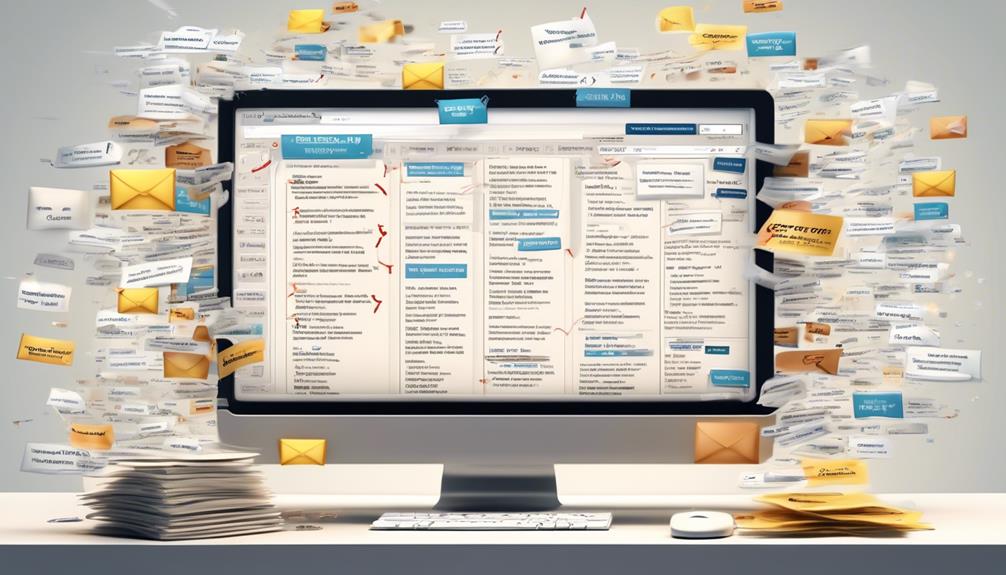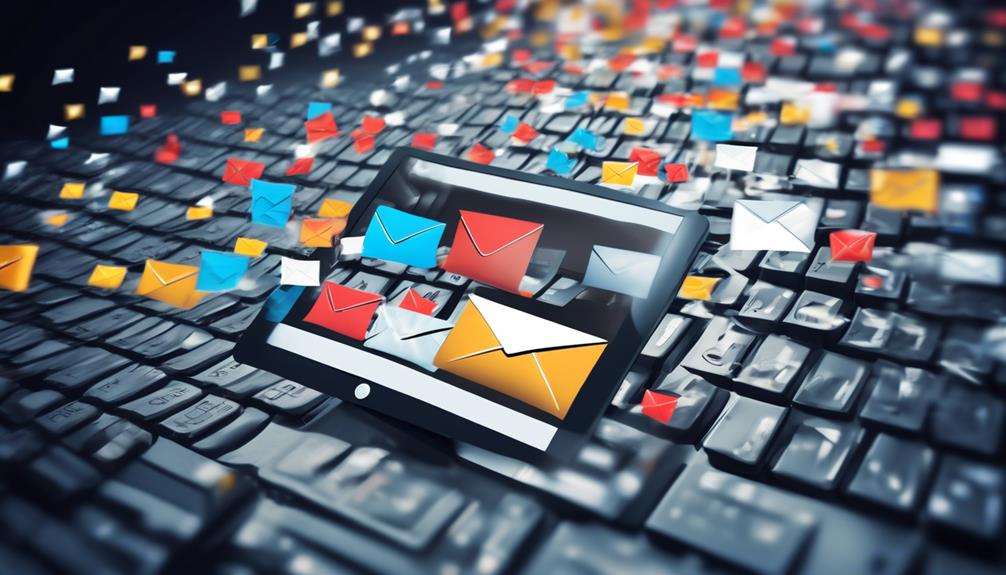When sending a large number of emails, it’s common to be concerned about them getting flagged as spam. But there are reliable techniques to ensure your emails make it to the recipient’s inbox without any issues.
By implementing proper email authentication, maintaining a clean mailing list, and optimizing email content and design, you can significantly increase the chances of your emails reaching the intended audience.
However, there are also other crucial factors to consider in this process. Let's explore together how to navigate the fine line between bulk emailing and spamming to achieve successful email marketing.
Key Takeaways
- Craft email content adhering to best practices and regulations
- Analyze recipient behavior and engagement metrics to track the effectiveness of your bulk emails
- Implement robust email authentication measures to track the spam level of your emails
- Employ double opt-in to ensure user consent and reduce the likelihood of spam complaints
Email Content and Design
To enhance deliverability and engagement, it's crucial to carefully craft the content and design of bulk emails, ensuring they adhere to best practices and regulations.
When it comes to email content, avoiding spam-like words is essential to prevent triggering spam filters. Additionally, the email design should refrain from using Caps Lock, excessive exclamation marks, hidden text, or an overabundance of images, while also being free of spelling mistakes. Providing a plain-text version of the email can significantly improve deliverability and accessibility for recipients.
It's also important to steer clear of suspicious links and attachments in the email content to maintain a high engagement rate. Furthermore, including an unsubscribe link that's prominently visible and easy to use isn't only a regulatory requirement but also contributes to positive engagement rates.
Adhering to regulations related to email headers and unsubscribe links is imperative for maintaining the desired level of email deliverability. By carefully considering these factors in email content and design, the overall effectiveness of an email marketing campaign can be greatly improved.
Reactions to Your Bulk Emails

Analyzing recipient behavior and engagement metrics provides invaluable insights into the effectiveness of your bulk email campaigns. It's crucial to monitor key metrics such as open rates, click-through rates, and unsubscribe rates to gauge the impact of your email marketing efforts. Below is a table outlining these important metrics and their implications:
| Metric | Implication |
|---|---|
| Open Rate | Indicates the percentage of recipients who opened your email, reflecting the effectiveness of your subject lines and sender details. |
| Click-Through Rate | Reflects the percentage of recipients who clicked on a link within your email, showcasing the relevance and appeal of your content. |
| Unsubscribe Rate | Signals the percentage of recipients who opted out of future emails, highlighting potential issues with email frequency or content quality. |
| Spam Complaints | Represents the number of recipients who marked your email as spam, impacting your sender reputation and deliverability to other recipients. |
Tracking the Spam Level of Your Emails
Tracking the spam level of your emails involves implementing robust email authentication measures, such as SPF records and DKIM signatures, to verify accuracy and sender identity. These measures help in avoiding spam triggers that could lead to your emails being marked as spam.
It's crucial to monitor email headers for Authentication-Results to confirm SPF and DKIM validation, ensuring a 'pass' status. Additionally, including an unsubscribe link and using header precedence: bulk in bulk emails maintains transparency and user choice, further contributing to good sender reputation.
Building a legitimate mailing list through double-opt-in confirmation and avoiding purchased lists can significantly reduce spam complaints.
Regularly monitoring email deliverability metrics and sender reputation, including IP reputation, helps ensure that your emails aren't marked as spam.
Employing Double Opt-In

When it comes to sending bulk emails without being flagged as spam, employing Double Opt-In is crucial.
This permission-based communication method ensures that users actively confirm their subscription, reducing the likelihood of spam complaints and ensuring user consent.
The confirmation email process is an essential aspect of Double Opt-In, as it verifies the accuracy of subscriber data and their interest in receiving your emails.
Permission-Based Communication
To ensure the highest level of consent and minimize spam complaints, utilizing a double opt-in verification process is essential for permission-based communication.
When sending bulk email, employing double opt-in verification offers several advantages:
- Enhanced Consent: By requiring subscribers to confirm their email addresses twice, their consent is validated, reducing the likelihood of spam complaints.
- Improved Sender Reputation: Building a quality list organically and engaging subscribers through targeted content helps maintain a positive IP reputation, crucial for effective email marketing.
- Reduced Spam Filter Impact: Double opt-in verification reduces the chances of emails being flagged as spam, ensuring that the message reaches the intended audience.
Employing double opt-in not only aligns with best practices for permission-based communication but also contributes to a more effective email marketing strategy.
Confirmation Email Process
How can the confirmation email process employing double opt-in enhance the legitimacy and effectiveness of email marketing strategies? Implementing a double opt-in confirmation process ensures that subscribers have actively consented to receiving emails, thereby reducing the risk of being flagged by spam filters. By incorporating a clear and prominent unsubscribe link in every email and employing double opt-in for all subscription forms, the legitimacy of bulk emailing is further established. This approach helps to maintain a positive IP reputation and ensures high engagement with the email campaigns. Additionally, avoiding the purchase of email lists and focusing on organic methods such as subscribe links and double opt-in reinforces the authenticity of the email lists, contributing to successful email marketing strategies.
| Key Points | Benefits |
|---|---|
| Double Opt-In Confirmation | Validates subscriber consent and reduces spam risk |
| Clear Unsubscribe Link | Establishes legitimacy and maintains positive IP rep |
| Organic List Building | Ensures authenticity and enhances email campaign success |
Building Your Own Email List

What are the most effective methods for ethically gathering email subscribers to build a legitimate mailing list?
When building an email list for sending bulk emails, it's crucial to employ ethical and effective methods to ensure the list is legitimate and engaged.
Here are some key strategies for building an email list:
- Opt-in Methods: Focus on collecting subscribers through opt-in methods like double opt-in confirmation, where users confirm their subscription twice. This helps ensure that subscribers are genuinely interested in receiving your emails.
- Visible Unsubscribe Link: Include a visible and accessible unsubscribe link in all your bulk emails. This not only complies with regulations such as CAN-SPAM but also helps maintain a positive sender reputation and reduces the likelihood of being flagged by spam filters.
- Avoid Buying Mailing Lists: Instead of purchasing email lists, invest effort in organically growing your subscriber base. This ensures that your list comprises individuals who are genuinely interested in your content, leading to better engagement and deliverability.
Cleaning Up Your Email List Regularly

Regularly maintaining and refining your email list is essential for optimizing deliverability and engagement. Cleaning up your email list regularly involves removing inactive and inaccurate email addresses, utilizing email verification, and removing non-engaging subscribers. By doing so, you can improve your sender reputation, reduce the risk of being marked as spam, and ensure that you maintain a quality and engaged subscriber base. Below is a table detailing the key steps for cleaning up your email list:
| Step | Description |
|---|---|
| Remove inactive email addresses | Identify and eliminate email addresses that have shown no activity. |
| Utilize email verification | Use tools to validate the accuracy and validity of email addresses. |
| Remove non-engaging subscribers | Regularly eliminate subscribers who have not engaged with your emails. |
Implementing these steps will help enhance the effectiveness of your bulk email sending, reduce the likelihood of triggering spam filters such as Spam Assassin, and ultimately improve the engagement with your email campaigns. Additionally, providing an easily accessible unsubscribe link and regularly cleaning your list can contribute to maintaining a positive reputation with Internet Service Providers and safeguarding your IP addresses from being blacklisted.
Evaluating Your Subject Line

When evaluating your subject line, we prioritize clarity, relevance, and personalization to captivate the recipient's attention and optimize engagement.
- Clarity: The subject line should clearly convey the purpose of the email, avoiding ambiguous or misleading language that could trigger spam filters.
- Relevance: Ensure that the subject line directly relates to the content of the email. Irrelevant or deceptive subject lines not only harm your IP reputation but also lead to decreased engagement.
- Personalization: Tailoring subject lines based on recipient preferences, interests, or past interactions can significantly increase engagement with marketing emails.
To avoid being flagged as spam, consider implementing Domain Keys Identified Mail (DKIM) and Email Authentication to authenticate your emails. These mechanisms help in establishing the legitimacy of your emails and can positively impact the deliverability of your messages.
Additionally, regularly testing different variations of your subject line through A/B testing can provide valuable insights into which approaches are most effective for your email list, ultimately enhancing engagement with your audience.
Providing an Unsubscribe Link

We must emphasize the importance of including an unsubscribe link in every bulk email we send.
This isn't just a best practice; it's a legal requirement for allowing recipients to opt out of further communications.
Providing an easily accessible unsubscribe link not only ensures compliance with regulations but also demonstrates respect for recipients' preferences.
Unsubscribe Link Importance
Providing a prominently displayed and easily visible unsubscribe link is crucial for allowing recipients to opt out of future communications. Failing to include this link can result in spam complaints, negatively impacting IP reputation and triggering spam filters. Additionally, omitting the unsubscribe link may violate anti-spam policies and lead to decreased engagement with the email list.
It's essential to ensure that the unsubscribe link is clearly visible and easily accessible to maintain a positive sender reputation. Moreover, utilizing authentication methods such as DKIM can enhance the legitimacy of the email addresses in the contact list, further supporting the effectiveness of the unsubscribe link.
Therefore, prioritizing the placement and visibility of the unsubscribe link is integral to maintaining a healthy email list and complying with anti-spam regulations.
Legal Requirements for Unsubscribing
To comply with legal requirements, every bulk email must include an easily accessible unsubscribe link. This link should be prominently displayed and clearly visible to subscribers. Legal regulations also mandate that the process to unsubscribe should be straightforward and hassle-free. By providing a visible and accessible unsubscribe link, companies prioritize subscriber preferences and comply with email marketing legality.
Failing to include a clear unsubscribe option can lead to spam complaints, damage the sender's IP reputation, and trigger spam filters. Additionally, employing double opt-in confirmation for all subscription forms ensures user consent, contributing to legal compliance and positive engagement with subscribers.
Avoiding the purchase of mailing lists from other companies is also crucial in preventing spam complaints and legal issues associated with unsolicited bulk email.
Employing a Good Email Marketing Tool

When selecting an email marketing tool, it's crucial to prioritize features that enable email authentication, list management, and performance monitoring for optimal results.
- Email Authentication: Choose a tool that supports SPF-record and DKIM-signature to verify the accuracy of emails and sender identity.
- List Management: Look for features that support building a legitimate mailing list organically, such as subscribe links, double opt-in confirmation, and avoiding purchased lists.
- Performance Monitoring: Ensure the tool provides monitoring capabilities for IP reputation, spam filters, and email domain and account health.
These features are essential for maintaining a good sender reputation, avoiding spam filters, and ensuring that emails are delivered effectively.
Additionally, the selected email marketing tool should comply with anti-spam regulations by including an unsubscribe link and using header precedence: bulk in bulk emails to provide easy opt-out options for recipients. By incorporating these functionalities, businesses can send bulk email campaigns without triggering spam filters and ensure that their emails reach the intended audience.
What is the Best Way to Send Bulk Emails Without Triggering Spam Filters?
The best way to send bulk emails without triggering spam filters is to ensure your email list is opt-in and up to date. Additionally, use a reputable email service provider that offers features like email authentication and spam filter testing to optimize delivery rates. This is what bulk email means.
Frequently Asked Questions
How Do I Send a Mass Email Without Getting Spammed?
We send mass emails without getting spammed by implementing email authentication, including clear unsubscribe links, and building a legitimate mailing list.
Crafting email content without spam-like words and maintaining an optimal sending frequency are essential.
By segmenting subscribers based on demographics and interests, we ensure relevant content.
Including an unsubscribe link in every email and using familiar sender details also contribute to avoiding spam filters.
How Do I Stop Bulk Emails From Going to Spam?
To stop bulk emails from going to spam, we implement several strategies:
- Email authentication: By verifying SPF-records and DKIM-signatures, we increase the chances of our emails reaching the inbox.
- Including an unsubscribe link: This allows recipients to easily opt out of receiving future emails, which can help prevent our messages from being marked as spam.
- Building a legitimate mailing list: We ensure that we have permission to email recipients by obtaining their consent through opt-in confirmation. This helps to reduce the likelihood of our emails being marked as spam.
- Minding email content and design: We avoid using spam-like words and suspicious links in our emails. We also pay attention to the overall design and formatting to ensure a professional and trustworthy appearance.
- Reacting responsibly: If recipients do mark our emails as spam, we take swift action by promptly removing them from our mailing list. This shows that we take recipients' preferences seriously and can help improve our email deliverability.
How Do You Send an Email Without It Going to Spam?
We send emails that avoid spam filters by implementing email authentication, including an unsubscribe link, and building a legitimate mailing list. Our content and design steer clear of spam triggers.
We engage responsibly, using familiar sender details and segmenting our emails for relevance.
Our approach reduces the risk of being marked as spam and ensures our emails reach their intended recipients.
How Can I Send 10000 Emails a Day for Free?
We can send 10,000 emails a day for free by leveraging email marketing platforms with robust free plans, like Mailchimp or Sendinblue.
These platforms offer features for managing large email volumes, including list segmentation, email automation, and analytics.
Conclusion
In conclusion, by carefully following the steps outlined, we can ensure that our bulk emails are sent without spamming.
It's ironic that the key to effective email marketing lies in avoiding spam-like tactics and prioritizing authenticity and value.
With proper authentication, content, and list management, we can reach our audience effectively and ethically.
Let's embrace the irony of avoiding spam to succeed in our email marketing endeavors.










